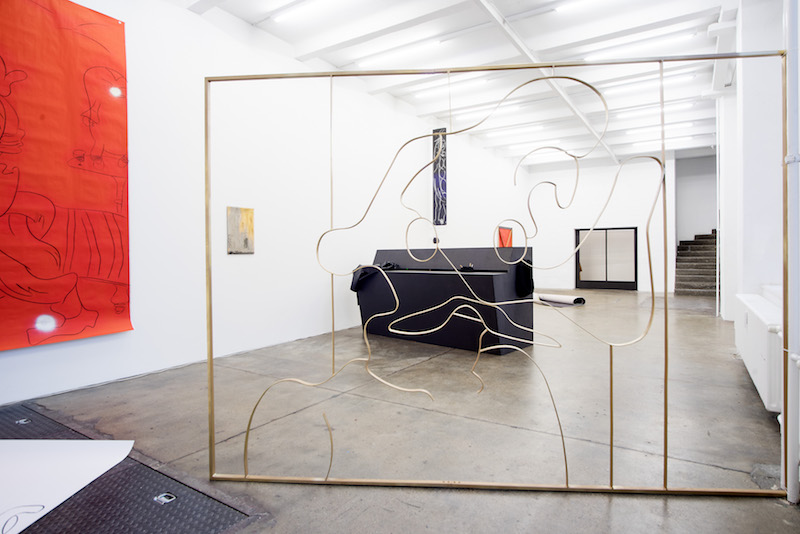 Ola Vasiljeva, "Gold Is the Metal With the Broadest Shoulders" at Supportico Lopez, Berlin, 2017
Ola Vasiljeva, "Gold Is the Metal With the Broadest Shoulders" at Supportico Lopez, Berlin, 2017
Photo © Linda Fuchs; © Ola Vasiljeva
Entering Ola Vasiljeva’s current exhibition “Gold Is the Metal With the Broadest Shoulders“ at Supportico Lopez in Berlin, one finds himself surrounded by drawings and sculptures in the term’s widest sense. Bearing titles like Ivan the Son of Bear, Memmie le Blanc at home in Paris, Big Prince and The Feral Thief, they form a community of social outcasts and mythical characters inhabiting a place somewhere between fact and fiction, history and illusion, dream and reality. The semi-imaginary, the tension between fiction and use, is central to the The Hague-based artist’s suggestive installations, in which metal sculptures seem to transfer the drawings into the three-dimensional and mirrored surfaces transform the exhibition space into a dream-like vision. In our conversation, Ola Vasiljeva talked about the site-specificity of her installations, her interest in the unintentional qualities of backstage areas and about how the idea of unlearning inflected her past projects.
Verena Kittel: Ola, in your installations you utilise a broad array of media such as drawings, sculptures, found objects, videos and slides. Could you talk a bit about your production process? How do you choose the objects? Do you think of them, right from the beginning, as part of a greater whole?
Ola Vasiljeva: I usually set out with an idea, which I would like to draw out and emphasise.
The space itself and the location play a huge role, so usually before building the work, I do a site visit and feel the space. This informs the production or the collecting process; I look for objects that reflect and are relevant to that particular place. In that way my work is very intuitive. When I have a few of these anchors that articulate the installation or the atmosphere – all the rest usually happens in situ. I source found items locally, embrace the architecture or the condition of the space and this adds new layers to the work. In case of the installation at Supportico Lopez, I produced a few suggestive objects from glass, ceramics and metal, which were communicating the sensibility of an interior of some sort of ambiguous erotic bar. All the rest I arranged, adorned and unfolded during the installation process.

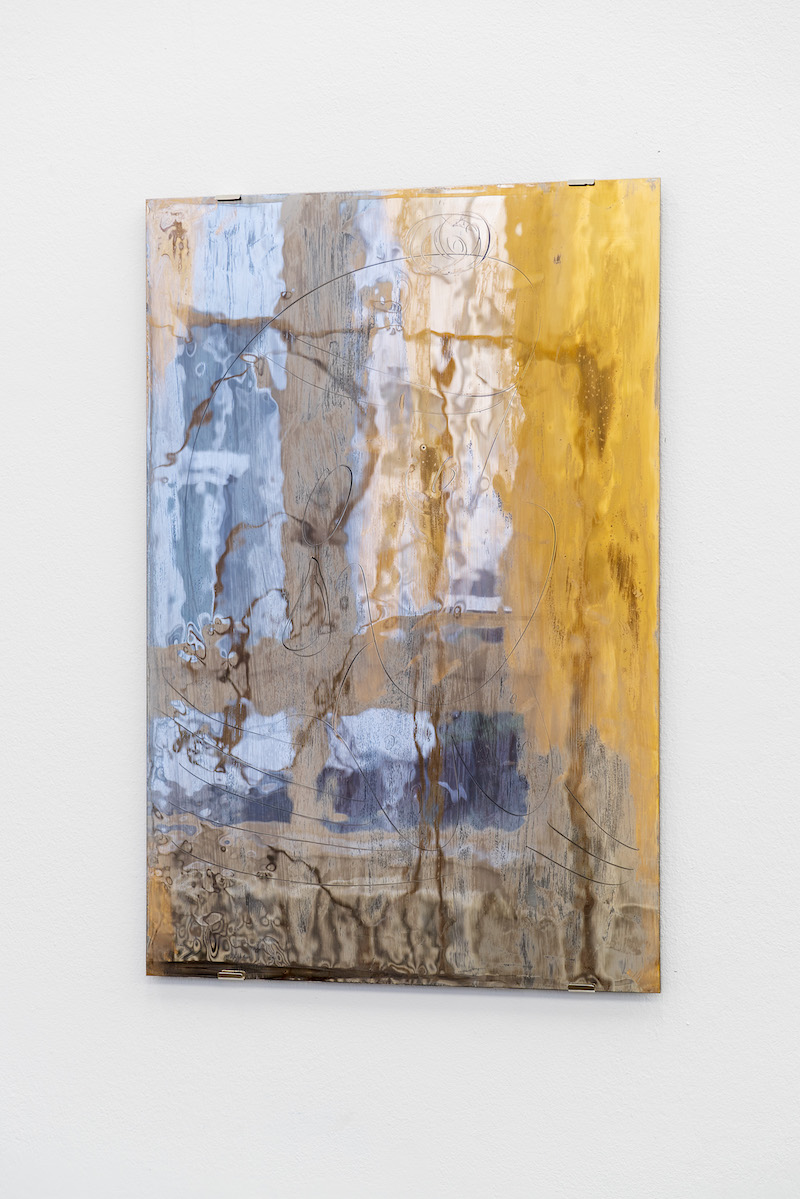
Ola Vasiljeva, "Gold Is the Metal With the Broadest Shoulders" at Supportico Lopez, Berlin, 2017
Photo © Linda Fuchs; © Ola Vasiljeva
VK: This means that for each exhibition you produce and use new objects that respond in different ways to the specific spaces they are presented in and thus not only enter into a dialogue with each other, but also with the surrounding space?
OV: That's right. If I happen to show the same installation more than once, it gets adapted and changed, some layers added. But I prefer to create a new setting each time.
VK: These kinds of dialogues you are opening up between the space and the objects, but also between the objects themselves, each of which already creating chains of associations and symbolic meanings, appear to me as belonging to a greater narrative following its own syntax. How would you describe these dialogues or narratives that you are evoking in your installations?
OV: My work is not exactly plot driven and less prescribed than a narrative. I guess, it is more suggestive. I enjoy playing with private references or absurdity but I would also love to see it form associations in the mind of the viewer. There are a few possible scenarios.
VK: So, I guess, in case of your installation at Supportico Lopez, in which the notion of community takes centre stage, by including characters like thieves or dead heroes, as well as objects like mirrors, you rather intend to raise questions about the term’s exclusive definition and use, instead of outlining a concrete idea of it.
OV: In the western world there are often rigid and austere tendencies dominating the understanding of community. I was interested in re-opening the idea of what a community could be. Supposing part of it could live in imagination entirely, it does not need to be continuously wrestled into the literal. This wrestling into the literal, the classified and the organised is something dull and often dangerous. I believe that moving into a mythic perspective saves us from continuously trying to address the situation from linear, statistical, clock time.
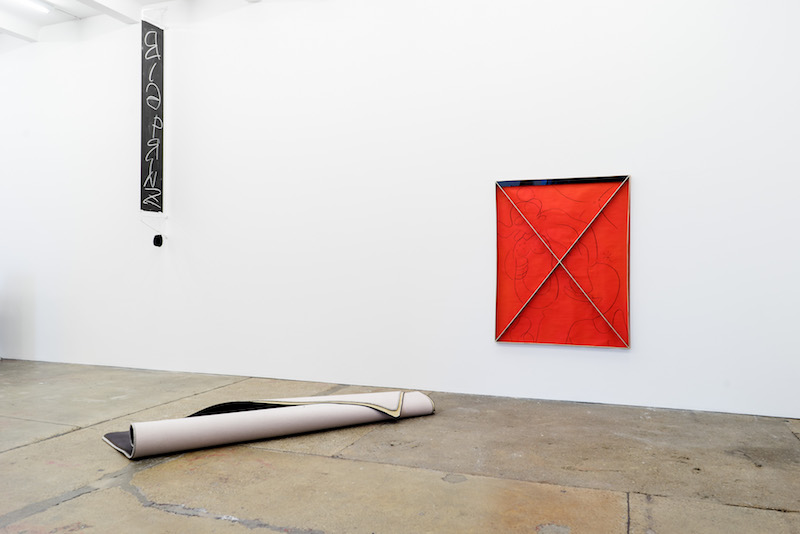

Ola Vasiljeva, "Gold Is the Metal With the Broadest Shoulders" at Supportico Lopez, Berlin, 2017
Photo © Linda Fuchs; © Ola Vasiljeva
VK: Seeing the show at Supportico Lopez, the feeling of absence was quite strong, as if the exhibited objects were remains or fragments of a story having been told or a performance having taken place already somewhere else. Could you tell me more about this, the role of the absence in your work?
OV: I am very much interested in the intermission moment, a liminal space, a place between other places. The kind of absence that is not about the ultimate abandonment, but rather a temporary displacement. I believe that a door half open is more inviting than an open door and a backstage is way richer than the main stage. My approach to building up a show requires this local sourcing, stealing building's mental furniture, living inside the work, cooking in it a little and this process leaves some sort of sediment, I guess. I believe this sediment can charge the work with a sense of a performance that took place.
VK: Your objects often resemble theatre props giving the whole installation an almost stage-like character. Could you, if there is any, further describe the theatrical dimension in your work?
OV: I guess my work is often referred to as theatrical or prop-like for a few reasons. One of them might be the absence of hierarchy in how I collect or arrange the objects. I tend to mix precious, delicate works together with dust, temporary sketches, tools, things. This slightly moves the viewer to the direction of reading the work rather as a stage than an exhibition.
I admire the world of theatre, but again I am the least interested in the main act or the actors, but rather in some sort of threshold logic of theatre. Theatre for me is very much about mimicry and act, but what fascinates me the most are the rooms and the air behind the curtain, the backstage kingdom, fitting rooms, corridors for the initiated – all those spaces and objects which are also filled with traces of props and mimicry, yet they are absolutely not arranged, nor staged. They just happen. Some storefronts that go out of business and show failed or given-up attempts to advertise the items have a similar allure. I love the unintentional quality of it. This detritus is charged with performance, but it is also displaced from the act or retired and carries only suggestive meaning, which is suspended between fiction and use.
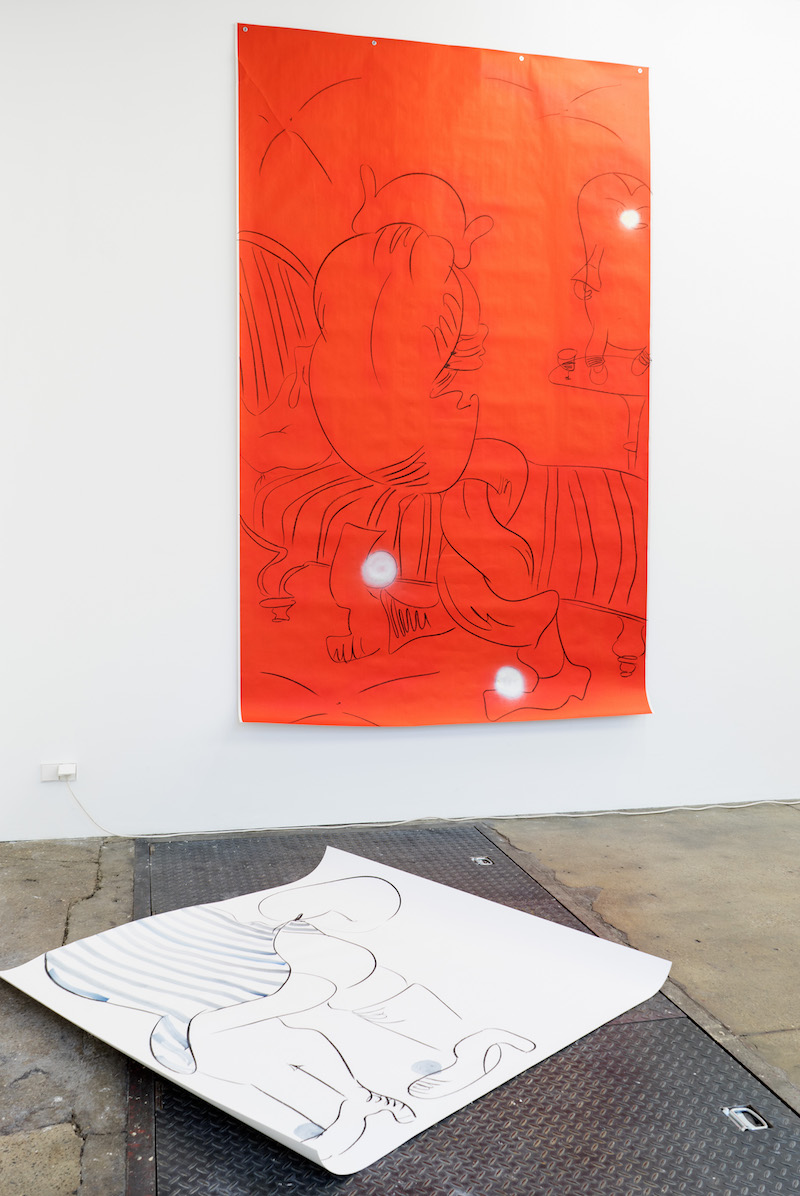

Ola Vasiljeva, "Gold Is the Metal With the Broadest Shoulders" at Supportico Lopez, Berlin, 2017
Photo © Linda Fuchs; © Ola Vasiljeva
VK: Where do you draw your inspiration from?
OV: My inspiration comes from literature, music, architecture, history, mythology, dreams. I get inspired by the environments of all these forms rather than their direct impact. Especially by the aura of premonition, by gaps, pauses, intermissions, aging.
VK: You founded the artist collective The Oceans Academy of Arts (OAOA) in 2008. What was its starting point and how is it organised?
OV: I started OAOA very spontaneously; initially it was a fictional online platform, which allowed to show work without any agenda or institutional expectations. It was fiction, it was absurd and therefore very liberating. This encouraged me to create events and exhibitions under the umbrella of OAOA. So there were a few anonymous events and collaborations taking place that involved dead artists, fictional characters, non-artists and colleagues. I found such a framework, which offered no explanation or justification very refreshing. With time OAOA got populated with existing artists, but remained an anonymous collective. Besides the exhibitions OAOA publishes editions of printed matter and other ephemera.
 Ola Vasiljeva, exhibition view "Zefiro Torna", Passerelle Centre d'art contemporain, photos © Aurélien Mole, 2017; © Ola Vasiljeva
Ola Vasiljeva, exhibition view "Zefiro Torna", Passerelle Centre d'art contemporain, photos © Aurélien Mole, 2017; © Ola Vasiljeva
 Ola Vasiljeva, exhibition view "Zefiro Torna", Passerelle Centre d'art contemporain, photos © Aurélien Mole, 2017; © Ola Vasiljeva
Ola Vasiljeva, exhibition view "Zefiro Torna", Passerelle Centre d'art contemporain, photos © Aurélien Mole, 2017; © Ola Vasiljeva
VK: What role does the idea of unlearning play in the OAOA?
OV: The idea of unlearning dominated my projects in the past years, but it was not necessary part of what OAOA is. OAOA is a larger collaborative boat and the University projects (2014–2016), which addressed questions around education or pedagogy, were part of it. But of course the idea of unlearning as an assault on dogmatic production of knowledge is a stand that OAOA believes in.
VK: So would you consider the OAOA’s University projects a sort of critique to today’s education system, proposing alternative strategies to traditional ways of producing and disseminating knowledge?
OV: I believe that the problem of education starts way before an art school. As part of the University projects OAOA proposed a few workshops and courses for children, which supported disobedience, lying and trickery techniques, as well as nonsense language to promote intuition and imagination as a source of learning. Ernesto from the short film by Straub-Huillet En rachâchant, with his rejection of official forms of education was a wonderful symbol for these projects. OAOA in general however is not a form of any critique, rather an amorphous, fictional theatre.
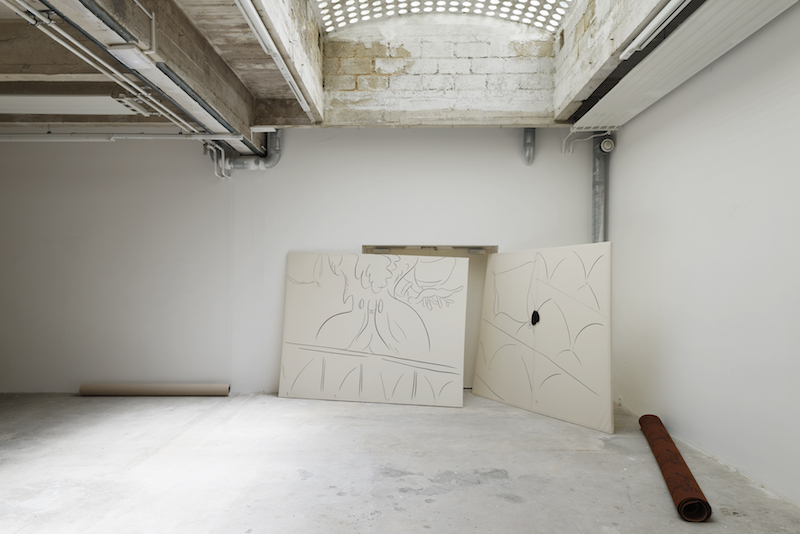
 Ola Vasiljeva, exhibition view "Zefiro Torna", Passerelle Centre d'art contemporain, photos © Aurélien Mole, 2017; © Ola Vasiljeva
Ola Vasiljeva, exhibition view "Zefiro Torna", Passerelle Centre d'art contemporain, photos © Aurélien Mole, 2017; © Ola Vasiljeva

 Ola Vasiljeva, exhibition view "Zefiro Torna", Passerelle Centre d'art contemporain, photos © Aurélien Mole, 2017; © Ola Vasiljeva
Ola Vasiljeva, exhibition view "Zefiro Torna", Passerelle Centre d'art contemporain, photos © Aurélien Mole, 2017; © Ola Vasiljeva
VK: You mentioned that the idea of unlearning dominated your past projects. Could you tell me a bit more about that?
OV: My projects in the recent years were concerned with the idea of nonsense, fragmentation and absurdity triumphing over the dogmatic and rigid common sense. Dismissing and ridiculing common sense as the only possible truth and path. Today’s education is mostly goal oriented and employs quite oppressive technique to feed selective knowledge to the pupils to prepare them for the market-oriented society, some sort of piggy-bank approach. I do not however propose to erase all knowledge and abandon the education system entirely. To fight the system, you need to be organised. But when the concept of organisation is also what you fight against, this attempt ultimately fails. As an artist I can address this topic and I can address it using fictional, nonsensical language and form. Neither OAOA nor this imaginary community here are organised in that sense, they are full of flaky characters, non-humans, questionable biographies, fragmented, misspelled and stolen manifestos.
Current Exhibitions
Gold Is the Metal With the Broadest Shoulders
Kurfürstenstraße 14/b
10785 Berlin
22.06.-29.07.2017
Opening Hours: Tue – Sat: 11am–6pm
Zefiro Torna
41, rue Charles Berthelot
29200 Brest, France
29200 Brest, France
03.06.2017 – 02.09.2017
Opening Hours: Tue: 2–8pm; Wed–Sat: 2–6.30pm
Upcoming Exhibitions
Bloemstraat 140
1016 LJ Amsterdam, Netherlands
Opening: 09.09.2017
Burggasse 4
8010 Graz, Austria
Opening: 01.12.2017
